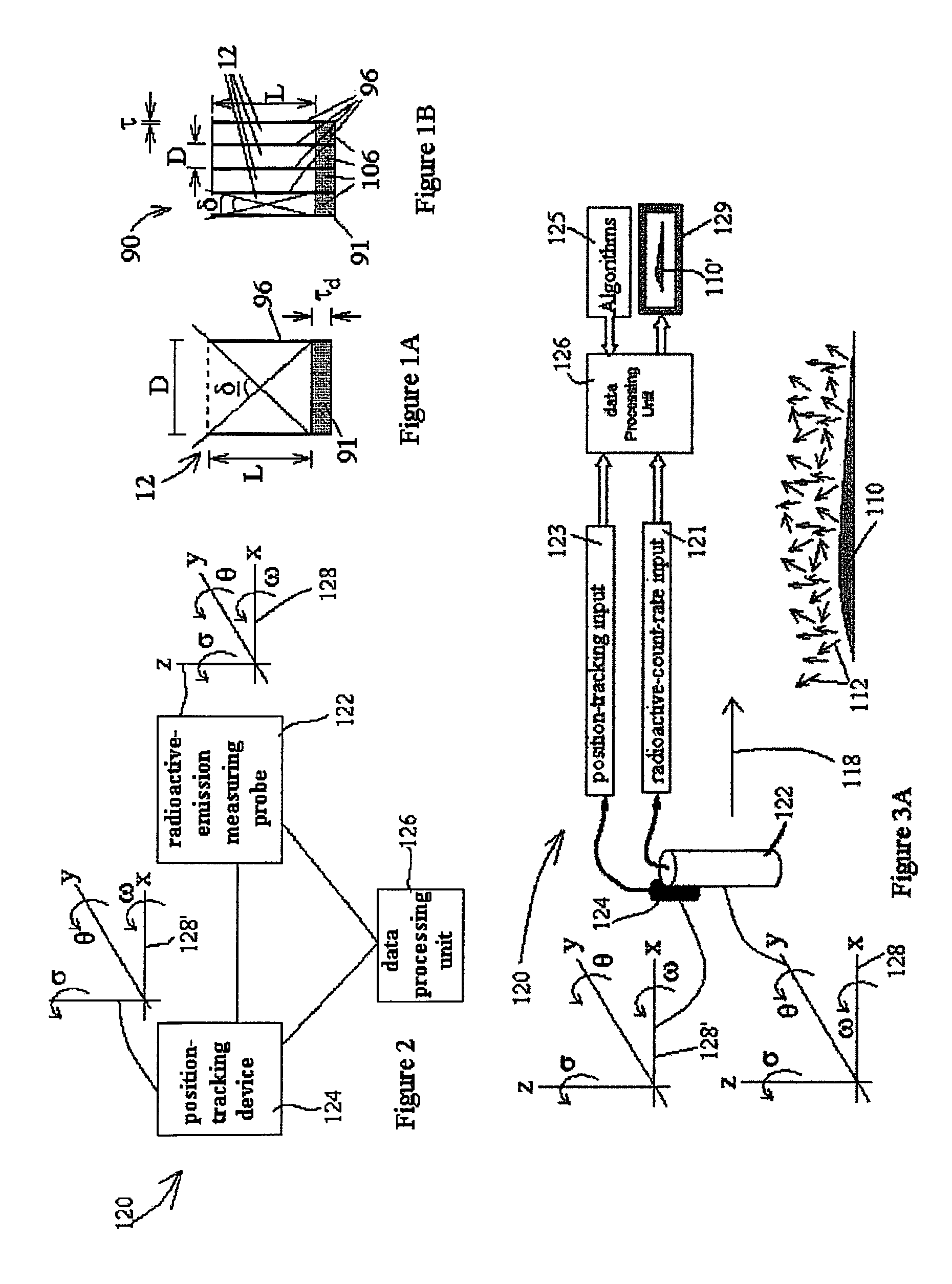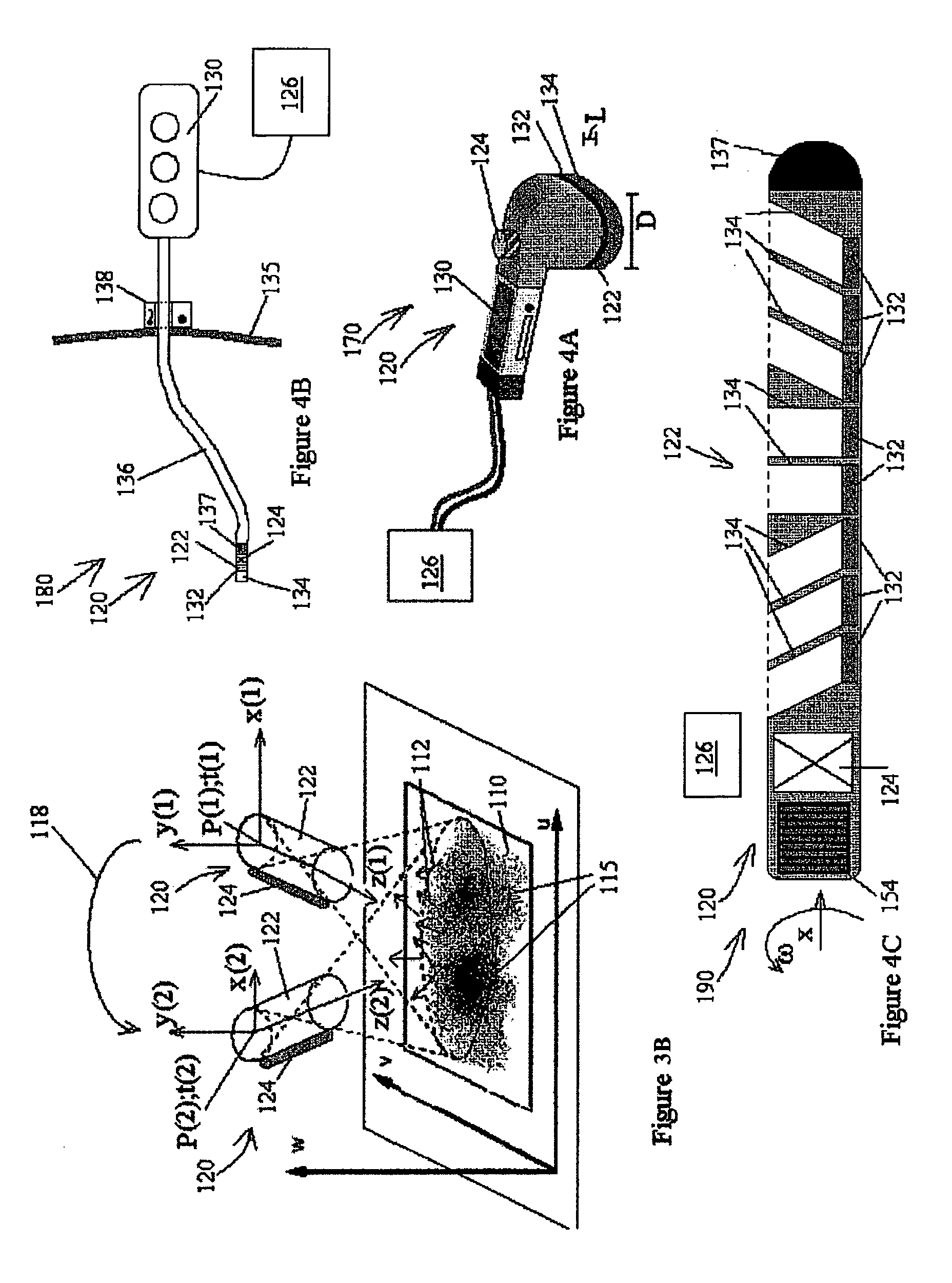Radioactive-emission-measurement optimization to specific body structures
a radioactive emission and optimization technology, applied in the field of nuclear imaging, can solve the problem that the two-dimensional image does not lend itself to the generation of two-dimensional images, and achieve the effect of rapid, inexpensive preliminary indication, and inexpensive and convenient hardwar
- Summary
- Abstract
- Description
- Claims
- Application Information
AI Technical Summary
Benefits of technology
Problems solved by technology
Method used
Image
Examples
example 1
[0299]Referring further to the drawings, FIGS. 17A-17H schematically illustrate detecting units 12 and blocks 90 that may be considered for possible probe designs.
[0300]FIGS. 17A and 17B schematically illustrate side and top views, respectively, of the basic detecting unit 12 (see also FIG. 1A), having a detector 91 and a wide-bore collimator 96, formed as a tube, of a collection angle δ1.
[0301]FIGS. 17C and 17D schematically illustrate side and top views, respectively, of the detecting unit 12, with the collimator 96 formed as a wide angle collimator, of a collection angle δ2.
[0302]FIGS. 17E and 17F schematically illustrate side and top views, respectively, of the block 90 (see also FIG. 1B) of the detecting units 12, with the collimator 96 formed as a grid, and each of the detecting unit 12 having a collection angle δ3. As few as two or four, and as many as a hundred or several hundred of the detecting units 12 may be included in the block 90.
[0303]FIGS. 17G and 17H schematically ...
example 2
[0309]Referring further to the drawings, FIGS. 18A and 18B schematically illustrate the radioactive-emission-measuring probe 10, of the single detecting unit 12 (see FIGS. 1A and 17A). The single detecting unit 12 has a motion with respect to the housing 20, which is a combination of a rotational motion around the x-axis, in the direction of ω, denoted by an arrow 44, and a translational motion along the x-axis, denoted by an arrow 46.
[0310]As a consequence, a spiral trace 48 is formed, for example, on an inner surface of a body lumen 232, as seen in FIG. 18B.
[0311]Preferably, the motions of the detecting unit 12 are contained within the housing 20, so that the external surface of the probe 10 remains stationary. The external surface of the probe may be formed of a carbon fiber, a plastic, or another material, which is substantially transparent to nuclear radiation.
example 3
[0312]Referring further to the drawings, FIGS. 18C and 18D schematically illustrate the radioactive-emission-measuring probe 10, of the single block 90 (FIGS. 1B and 17E). Note that all the detecting units 12 of the single block 90 move as a single body. The single block 90 has a motion with respect to the housing 20, which is a combination of the rotational motion around the x-axis, in the direction of ω, denoted by the arrow 44, and the translational motion along the x-axis, denoted by the arrow 46.
[0313]As a consequence, a plurality of spiral traces 49 is formed, for example, on an inner surface of a body lumen, as seen in FIG. 18D.
[0314]Preferably, the motions of the block 90 are contained within the housing 20, so that the external surface of the probe 10 remains stationary, wherein the external surface of the probe is substantially transparent to nuclear radiation.
PUM
| Property | Measurement | Unit |
|---|---|---|
| diameter | aaaaa | aaaaa |
| diameter | aaaaa | aaaaa |
| radioactive- | aaaaa | aaaaa |
Abstract
Description
Claims
Application Information
 Login to View More
Login to View More - R&D
- Intellectual Property
- Life Sciences
- Materials
- Tech Scout
- Unparalleled Data Quality
- Higher Quality Content
- 60% Fewer Hallucinations
Browse by: Latest US Patents, China's latest patents, Technical Efficacy Thesaurus, Application Domain, Technology Topic, Popular Technical Reports.
© 2025 PatSnap. All rights reserved.Legal|Privacy policy|Modern Slavery Act Transparency Statement|Sitemap|About US| Contact US: help@patsnap.com



